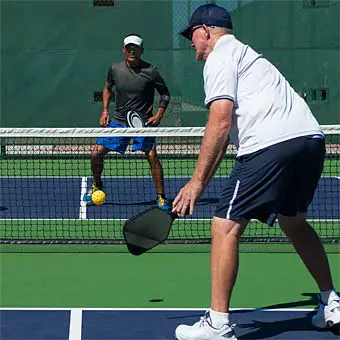Easy Pickleball Rules for Beginners

Get Started with Pickleball in Minutes
Pickleball is simple, fun, and perfect for beginners! This easy rule guide covers what a new player needs to know to help you start playing right away. Don't stress about advanced rules—just grab a paddle, head to the court, and enjoy the game. Learn as you go and focus on having fun!
Here's all you need to know to begin playing pickleball today:
Pickleball Rules for Beginners
1. Serving
Start by hitting the ball underhand to the opposite side.
The serve is an underhand stroke where the paddle contacts the ball below your waist. Stand behind the baseline and hit the ball diagonally to the opponent's service area. This starts the rally.
The ball must land in the opposite (diagonal) box, past the kitchen line.
When serving, the ball must land in the diagonal service box on the opponent's side of the court, clearing the kitchen (non-volley zone closest to the net) to count as a valid serve. A short serve or one that lands outside the lines is a fault.
Both partners get a turn to serve before the other team takes over.
Each player on the serving team gets one turn to serve during a rotation. If the first server loses their rally, the second server takes over. Only after both players have served does the serve switch to the opposing team.
2. Let It Bounce
After the serve, each side must let the ball bounce once before hitting it.
The double-bounce rule means the ball must bounce once on your opponent's side after the serve and once on your side before it can be volleyed (hit in the air). This rule ensures fair play and prevents overly aggressive shots at the start of a rally.
3. Stay Out of the Kitchen
Don't stand in the kitchen (the area close to the net) unless the ball bounces there first.
The kitchen, or non-volley zone, is a 7-foot area on both sides of the net. You cannot hit the ball out of the air while standing in this zone. You may enter the kitchen to hit a ball that has bounced there, but you must exit promptly to avoid faults.
4. Keep the Ball In Play
Hit the ball over the net and keep it inside the lines.
Rallies continue as long as the ball is hit over the net and lands within the court boundaries. If the ball goes out, hits the net without crossing, or bounces twice on one side, the rally ends, and the other team gets the point or serve.
5. Win Points
Only the serving team can score points. Keep serving until you lose.
Points are awarded only to the team that is serving. If the serving team loses the rally, the current server gives up the serve. If it's the first server, their partner gets the next serve. Once both servers lose, the serve goes to the other team.
When your team scores a point, switch sides (left/right) with your partner.
Each time your team scores a point, you and your partner switch sides of the court and serve again. This rotation ensures the serve alternates diagonally and maintains fairness in gameplay.
Games go to 11 points (win by 2).
Standard pickleball games are played to 11 points, but a team must lead by at least 2 points to win. For example, a game tied at 10-10 will continue until one team gains a 2-point advantage.
Bonus: Calling the Score
Why calling the score is important
Calling the score before serving helps keep the game organized and ensures that all players know the current score and who should be serving. It also prevents confusion or disputes during the game.
Step 1: Say your team's score first
Start with the number of points your team has earned so far. For example, if your team has 4 points, you begin with "4." Always call your score before moving to the opponent's score.
Step 2: Say your opponent's score
After stating your team's score, say how many points the opposing team has. For example, if they have 2 points, you would call "4-2." This ensures everyone knows the overall score.
Step 3: Say the server number
Finish by saying whether you are the first server ("1") or the second server ("2"). For example, if it's your first turn to serve in this rotation, you would say "4-2-1." This identifies who is serving and maintains proper rotation.
Step 4: Example full call
If your team has 4 points, the other team has 2 points, and you are the first server, the complete score call would be "4-2-1." Always make this call loudly and clearly before serving.
Step 5: What to do if it's the second server's turn
If the first server has lost their serve and it's now your partner's turn, they would call the score as "4-2-2." This shows that it's the second server's turn in this rotation.
Step 6: When the second server loses the serve
If the second server also loses the rally, the serve switches to the opposing team. The opponents will now call their score first, followed by your team's score, and their server number. For example, since the score was "4-2-2," the opponents would call "2-4-1" as it's now their first server's turn.
What to do if you make a mistake
If you realize you've called the score incorrectly, you can correct it before serving. Simply announce the correct score loudly and proceed with your serve.
